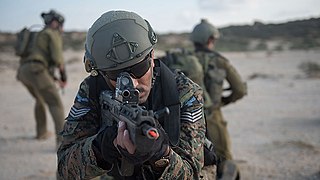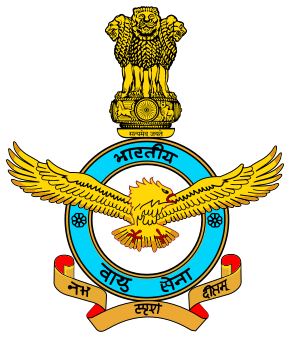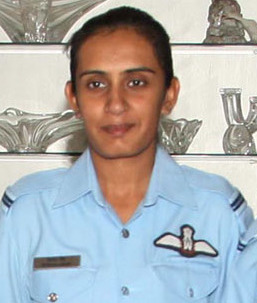The United States Armed Forces are the military forces of the United States of America. The armed forces consists of six service branches: the Army, Marine Corps, Navy, Air Force, Space Force, and Coast Guard. The president of the United States is the commander-in-chief of the armed forces and forms military policy with the Department of Defense (DoD) and Department of Homeland Security (DHS), both federal executive departments, acting as the principal organs by which military policy is carried out. All six armed services are among the eight uniformed services of the United States.
Second lieutenant is a junior commissioned officer military rank in many armed forces, comparable to NATO OF-1a rank.

India has several special forces (SF) units. The three branches of the Indian Armed Forces have separate special forces units, viz. the Para SF of the Indian Army, the MARCOS of the Indian Navy and the Garud Commando Force of the Indian Air Force. There are other special forces which are not controlled by the military but operate under civilian organisations such as Home ministry’s National Security Guard. Small groups from the military SF units are deputed in the Armed Forces Special Operations Division, which has a unified command and control structure.

The Indian Air Force (IAF) is the air arm of the Indian Armed Forces. Its complement of personnel and aircraft assets ranks fourth amongst the air forces of the world. Its primary mission is to secure Indian airspace and to conduct aerial warfare during armed conflict. It was officially established on 8 October 1932 as an auxiliary air force of the British Empire which honoured India's aviation service during World War II with the prefix Royal. After India gained independence from United Kingdom in 1947, the name Royal Indian Air Force was kept and served in the name of Dominion of India. With the government's transition to a Republic in 1950, the prefix Royal was removed.
Flying officer is a junior commissioned rank in the Royal Air Force (RAF) and the air forces of many countries which have historical British influence. It is also sometimes used as the English translation of an equivalent rank in countries which have a non-English air force-specific rank structure. In these cases a flying officer usually ranks above pilot officer and immediately below flight lieutenant.
Flight lieutenant is a junior commissioned rank in air forces that use the Royal Air Force (RAF) system of ranks, especially in Commonwealth countries. It has a NATO rank code of OF-2. Flight lieutenant is abbreviated as Flt Lt in the Indian Air Force (IAF) and RAF, and as FLTLT in the Pakistan Air Force (PAF), Royal Australian Air Force (RAAF) and Royal New Zealand Air Force (RNZAF) and has sometimes also been abbreviated as F/L in many services; however, it has never been correctly abbreviated as "lieutenant". A flight lieutenant ranks above flying officer and below a squadron leader and is sometimes used as an English language translation of a similar rank in non-English-speaking countries.

The Garud Commando Force is the special forces unit of the Indian Air Force. It was formed in September 2004 and has a current strength of over 1500 personnel. The unit derives its name from Garuda, a divine bird-like creature in Hindu mythology.

The Indian Armed Forces are the military forces of the Republic of India. It consists of three professional uniformed services: the Indian Army, Indian Navy, and Indian Air Force. Additionally, the Indian Armed Forces are supported by the Central Armed Police Forces, Assam Rifles, Indian Coast Guard and Special Frontier Force and various inter-service commands and institutions such as the Strategic Forces Command, the Andaman and Nicobar Command and the Integrated Defence Staff. The President of India is the Supreme Commander of the Indian Armed Forces. The Indian Armed Forces are under the management of the Ministry of Defence (MoD) of the Government of India. With strength of over 1.4 million active personnel, it is the world's second-largest military force and has the world's largest volunteer army. It also has the third-largest defence budget in the world. As per 2015 Credit Suisse report, the Indian Armed Forces is the world's fifth-most powerful military, whereas the 2020 GlobalFirepower report lists it as the fourth most-powerful military.

Women in combat refers to female military personnel assigned to combat positions. The role of women in the military has varied across the world’s major countries throughout history with several views for and against women in combat.
This list is about women in warfare and the military from 1945 to 1999.
This article is about women in warfare and the military (2000–present) throughout the world outside the United States. For women in warfare and the military in the United States since 2000, please see: Timeline of women in warfare and the military in the United States, 2000–2010 and Timeline of women in warfare and the military in the United States from 2011–present.
Recent history of changes in women's roles includes having women in the military in many countries. Although most countries in the world permit the participation of women in the military, in one form or another, in 2018, only two countries conscripted women and men on the same formal conditions: Norway and Sweden. A few other countries have laws allowing for the conscription of women into their armed forces, however with some difference such as service exemptions, length of service, and more. Some countries do not have conscription, but men and women may serve on a voluntary basis under equal conditions.

Central Armed Police Forces (CAPFs) refers to uniform nomenclature of five Central Armed Police Forces of the Union of India under the authority of the Ministry of Home Affairs. Their role is to defend the national interest mainly against the internal threats. They are the Border Security Force (BSF), Central Reserve Police Force (CRPF), Central Industrial Security Force (CISF), Indo-Tibetan Border Police (ITBP) and the Sashastra Seema Bal (SSB).

Women in the Pakistan Armed Forces are the female officers who serve in the Pakistan Armed Forces. Women have been taking part in Pakistani military since 1947, after the establishment of Pakistan. In 2006, the first women fighter pilot batch joined the combat aerial mission command of PAF. The Pakistan Navy prohibits women from serving in the combat branch. Rather they are appointed and serve in operations involving military logistics, staff and senior administrative offices, particularly in the regional and central headquarters. There was a rise in the numbers of women applying for the combat branch of PAF in 2013.
Seema Rao, sometimes referred to as India's Wonder Woman, is India's first woman commando trainer, having trained Special Forces of India for over two decades without compensation. She is an expert in close quarter battle (CQB) — the art of fighting in tight proximity — and is involved in training various Indian forces. She works in partnership with Major Deepak Rao, her husband.

Flight Lieutenant Avani Chaturvedi is an Indian pilot from Rewa district, Madhya Pradesh. She was declared as the first woman combat pilot along with two of her cohorts, Mohana Singh Jitarwal, and Bhawana Kanth. The trio was inducted into the Indian Air Force fighter squadron in June 2016. They were formally commissioned by then Defence Minister Manohar Parrikar on 18th June 2016, to serve the nation.

Bhawana Kanth is one of the first female fighter pilots of India. She was declared as the first combat pilot along with two of her cohort, Mohana Singh, and Avani Chaturvedi. The trio was inducted into the Indian Air Force fighter squadron in June 2016. They were formally commissioned by Defence Minister Manohar Parrikar. After the government of India decided to open the fighter stream in India Air Force for women on an experimental basis, these three women were the first to be selected for the program.

Mohana Singh Jitarwal is one of the first female fighter pilots of India. She was declared as the first female combat pilot along with two of her cohort, Bhawana Kanth, and Avani Chaturvedi. All three women pilots were inducted into the Indian Air Force fighter squadron in June 2016. They were formally commissioned by Defence Minister Manohar Parrikar. After the government of India decided to open the fighter stream in India Air Force for women on an experimental basis, these three women were the first to be selected for the program.
Flight Lieutenant Gunjan Saxena is an Indian Air Force (IAF) officer and former helicopter pilot. She joined the IAF in 1994 and is a 1999 Kargil War veteran. She is the one of two women IAF officers to be part of the Kargil War, making her the second woman IAF officer after Srividya Rajan, her colleague, to go to war. She is the first of two women along with Flight Lieutenant Srividya Rajan from the IAF to enter a war zone flying Cheetah helicopters. One of her main roles during the Kargil War was to evacuate the wounded from Kargil, transport supplies and assist in surveillance. She would go on to be part of operations to evacuate over 900 troops, both injured and deceased, from Kargil. In 2004, after serving as a pilot for eight years, her career as a helicopter pilot ended; permanent commissions for women were not available during her time.
Vijayalakshmi Ramanan VSM was an Indian physician and career army officer. She was the first woman to be commissioned as an Indian Air Force officer, and served as a surgeon in several military hospitals in India. She was a recipient of the army's Vishisht Seva Medal in 1977 and retired as a wing commander in 1979.
















